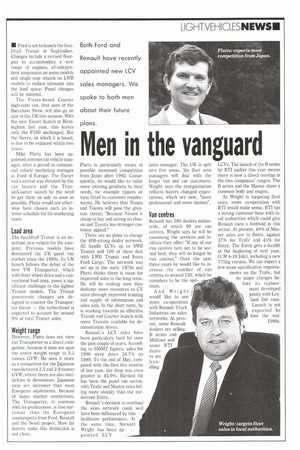Men in the vanguard
Page 19

If you've noticed an error in this article please click here to report it so we can fix it.
Both Ford and Renault have recently appointed new LCV sales managers. We spoke to both men about their future plans.
• Ford is set to launch the face lifted Transit in September. Changes include a revised floorpan to accommodate a new range of engines, all-independent suspension on some models and single rear wheels on LWB models to reduce intrusion into the load space. Panel changes will be minimal.
The Fiesta-based Courier high-cube van, first seen at the Barcelona Show, will also go on sale in the UK this autumn. With the new Escort launch at Birmingham last year, this leaves only the P100 unchanged. But the Sierra, on which it is based, is due to be replaced within two years.
Mike Platts has been appointed commercial vehicle manager, after a period as commercial vehicle marketing manager at Ford of Europe. The Escort van's arrival was dictated by the car launch and the Transit/Courier launch by the need to get them on sale as soon as possible. Platts would not otherwise have chosen such an intense schedule for his marketing team.
Load area
The facelifted Transit is an important new vehicle for the company. Previous models have dominated the UK panel van market since the 1960s. Its UK launch follows the debut of the new VW Transporter, which with front wheel drive and a conventional load area, poses a significant challenge to the lighter Transit models. The Transit powertrain changes are designed to counter the Transporter threat — the turbo-diesel is expected to account for around 9% of total Transit sales.
Weight range
llowever, Platts does not view the Transporter as a direct competitor, because it does not span the entire weight range to 3.5 tonnes GVW. He sees it more as a competitor for the Japanese vans between 2.5 and 2.8 tonnes GVW, where there are also similarities in dimensions. Japanese vans are narrower than most European equivalents, because of home market restrictions. The Transporter, in common with its predecessor, is also narrower than its European counterparts from Ford, Renault and the Sevel project. How far buyers make this distinction is not clear. Platts is particularly aware of possible increased competition from Japan after 1992. Consequently, he would like to tailor more existing products to local needs, for example tippers or vans fitted to customer requirements. He believes that Nissan and Toyota will pose the greatest threat: `Because Nissan is cheap to buy and strong on chassis and Toyota has stronger customer appeal."
There are no plans to change the 400-strong dealer network. All handle LCVs up to SWB Transit and 100 of them deal with LWB Transit and Iveco Ford Cargo. The network was set up in the early 1970s and Platts thinks there is room for improved sales in the long term. He will be making sure they dedicate more resources to CV sales through improved training and supply of information and sales aids. In the short term, he is working towards an effective Transit and Courier launch with more Transits available for demonstration drives.
Renault's LCV sales have been particularly hard hit over the past couple of years. According to SMMT figures, sales for 1990 were down 34.7% on 1989. To the end of May, cornpared with the first five months of last year, the drop was even greater at 45.9%. Hardest hit has been the panel van sector, with Trafic and Master sales falling more steeply than the carderived Extra.
Renault's decision to overhaul the sales network could well have been influenced by this Lacklustre performance. At the same time, Stewart Wright has been ap pointed LCV sales manager. The UK is split into five areas. Six fleet area managers will deal with the larger van and car customers. Wright says the reorganisation reflects buyers changed expectations, which are now, "more professional and more mature".
Van centres
Renault has 280 dealers nationwide, of which 90 are van centres. Wright says he will be examining the services and facilities they offer: "If any of our van centres turn out to be second best, they will no longer be van centres." Over the next three years he would like to increase the number of van centres to around 120, which he considers to be the optimum.
And Wright would like to see more co-operation with Renault Truck Industries on sales networks. At present, some Renault dealers are selling B series and Midliner and
some RTI deale
rs are
han
dling
LCVs. The launch of the B series by RTI earlier this year means there is now a direct overlap in the two companies' ranges. The B series and the Master share a common body and engine.
As Wright is targeting fleet sales, more co-operation with RTI would make sense. RTI has a strong customer base with local authorities which could give Renault vans a foothold in this sector. At present, 49% of Master sales are to fleets, against 37% for Trafic and 45% for Extra. The Extra gets a facelift at the beginning of next year, (CM 4-10 July), including a new 775kg version. We can expect a few more specification improvements on the Trafic, but no major changes before its replacement developed jointly with Leyland Daf vans. Launch is not expected be fore the mid1990s.












































































